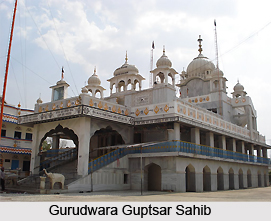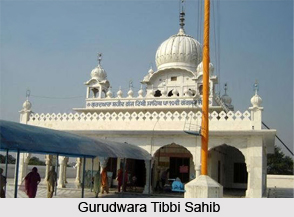 Pilgrimage tourism in Muktsar District comprises visits to some ancient Gurudwaras, temples and mosques. Muktsar city and its surrounding areas are intimately associated with Sikh history. Tuti Gandi Gurudwara Sahib, Tibbi Sahib, Gurudwara Rakabsar, Gurudwara Taran Taran Sahib are worth a visit to get a peep into the glorious era of Sikh tradition. The birthplace of Guru Angad Dev is at Sarai Naga 15 kms from Muktsar on Muktsar- Kotkapura highway. Further, there is a beautiful old mosque called Angooran Wali Maseet and one historical Gurudwara Guptsar Sahib is situated at village Chhatteana in Gidderbaha tehsil at about 24 kms from Muktsar.
Pilgrimage tourism in Muktsar District comprises visits to some ancient Gurudwaras, temples and mosques. Muktsar city and its surrounding areas are intimately associated with Sikh history. Tuti Gandi Gurudwara Sahib, Tibbi Sahib, Gurudwara Rakabsar, Gurudwara Taran Taran Sahib are worth a visit to get a peep into the glorious era of Sikh tradition. The birthplace of Guru Angad Dev is at Sarai Naga 15 kms from Muktsar on Muktsar- Kotkapura highway. Further, there is a beautiful old mosque called Angooran Wali Maseet and one historical Gurudwara Guptsar Sahib is situated at village Chhatteana in Gidderbaha tehsil at about 24 kms from Muktsar.
Some of the historical Gurudwaras of Muktsar District are as follows -
Gurudwara Shahidganj Sahib: Also called Arigitha Sahib, it marks the spot where the bodies of the martyrs were cremated by Guru Gobind Singh. It was first built in 1870 by Raja Wazir Singh of Faridkot (1828 - 1872). The new building, a rectangular domed hall, was reconstructed during the 1980`s.
Sri Darbar Sahib: This is one of the principal shrines at Muktsar, and was the earliest to be established by the first few Sikh families who had settled here around 1743.
 Additions to the building were carried out by Bhai Desu Singh and Bhai Lal Singh, chiefs of Kaithal, and later by Sardar Hari Singh Nalva (1791-1837), Maharaja Ranjit Singh`s army generals. During the 1930`s Sant Gurmukh Singh Karsevavale and Sant Sadhu Singh renovated the building. They marble panelled its walls, added decorative domes on top and paved the floor with marble. This edifice was, however, pulled down by his followers for reconstruction during the 1980`s. A high tower and flag post close to Darbar Sahib were raised by Maharaja Hira Singh of Nabha (1843 - 1911) during the 1880`s. An old van tree believed to have existed since before the battle of Muktsar still stands between the Divan Asthan and the Nishan Sahib.
Additions to the building were carried out by Bhai Desu Singh and Bhai Lal Singh, chiefs of Kaithal, and later by Sardar Hari Singh Nalva (1791-1837), Maharaja Ranjit Singh`s army generals. During the 1930`s Sant Gurmukh Singh Karsevavale and Sant Sadhu Singh renovated the building. They marble panelled its walls, added decorative domes on top and paved the floor with marble. This edifice was, however, pulled down by his followers for reconstruction during the 1980`s. A high tower and flag post close to Darbar Sahib were raised by Maharaja Hira Singh of Nabha (1843 - 1911) during the 1880`s. An old van tree believed to have existed since before the battle of Muktsar still stands between the Divan Asthan and the Nishan Sahib.
Gurudwara Tibbi Sahib: Marking the sandy mound from where Guru Gobind Singh attacked the enemy during the battle of Muktsar, this shrine was first established as a modest structure during the 18th century, and reconstructed in 1843 by Sodhi Man Singh. The present building is a square hall with the sanctum in the centre. Above the sanctum is a square pavilion topped by a lotus dome and decorative marble kiosks at corners. The entire wall surface including the dome is lined with white marble. The floor in and around the hall is also marble topped.
Gurudwara Rakabsar Sahib: It is located 200 metres east of Gurdwara Tibbi Sahib, constructed by Baba Baghel Singh during the 1950`s.
Control of Sri Darbar Sahib and other shrines in Muktsar was initially in the hands of hereditary `mahants` or priests but eventually it passed in the hands of Shiromani Gurdwara Parbandhak Committee in February 1923. The major annual celebration is on the Maghi day (mid January) when huge numbers of devotees gather here to offer their prayers. Pilgrimage tourism in Muktsar District attracts people from different parts of the country.



















